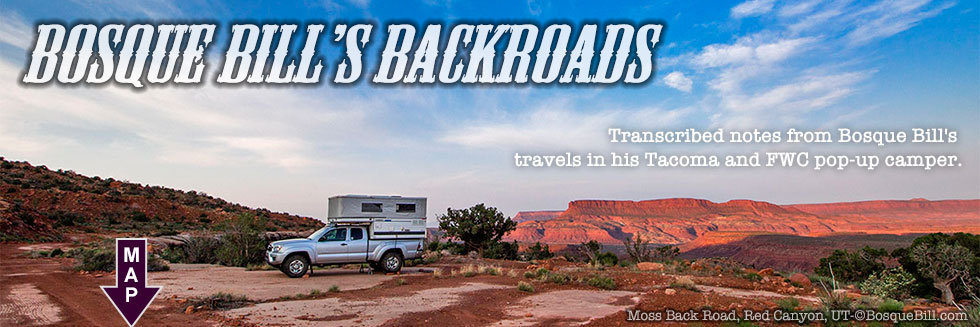Important Note: I am organizing this trip report into separate sections to both make it easier to read and to organize the geographical areas for your future trip planning.
- Part I comprises part of Wednesday and part of Saturday covering El Malpais National Monument. This breaks the timeline, but puts all of El Malpais in one section.
- Part II covers the rest of Wednesday, Thursday, Friday, and Saturday morning in the Apache and Gila National Forests.
- Part III covers El Morro National Monument from Saturday evening through Sunday afternoon.
- This final section is primarily a photo gallery of the inscriptions of El Morro National Monument.
IV. El Morro Inscription Photo Gallery
Sunday, May 24, 2015
The Inscription Trail begins behind the Visitor Center and leads to Inscription Pool, then along the base of the bluff. This also leads to the Headland Trail that winds up to the top where there are ancient pueblo ruins. If you have the time I recommend taking the 2 mile loop to the top, not only for the history, but also for the amazing views.
The Inscriptions
"Explorers and travelers have known of the pool by the great rock for centuries. A valuable water source and resting place, many who passed by inscribed their names and messages in the rock next to petroglyphs left by ancient Puebloans. The ruins of a large pueblo located on top of El Morro were vacated by the time the Spaniards arrived in the late 1500s, and its inhabitants may have moved to the nearby pueblos in Zuni and Acoma. As the American West grew in population, El Morro became a break along the trail for those passing through and a destination for sightseers. As the popularity of the area increased, so did the tradition of carving inscriptions on the rock. To preserve the historical importance of the area and initiate preservation efforts on the old inscriptions, El Morro was established as a national monument by a presidential proclamation on December 8, 1906."
-- From the El Morro NM website.
For additional information I have added some suggested links at the end of this post.
In the early part of the 20th Century, park rangers darkened some of the inscriptions with soft pencils to "preserve" them and allow them to more easily be read. This discredited practice has long since been abandoned, but the graphite from their efforts is still all too visible. Inscriptions that were left alone may be more difficult to make out, but don't leave one with the uncomfortable feeling of defacement. If you are interested in surveying and preservation, check out the Archaeology Southwest link below.
This is just a small sample of the inscriptions and engravings. I will attempt to present them in chronological order. There are more complete descriptions on some of the photos; click on them to enlarge.
Ancient Peoples
The earliest marks on the rock are from ancient puebloans. These are in the form of petroglyphs pecked into the facia of the rock, some more deeply than others. These may be as much as 2000 years old. Made by people believed to be the ancestors of the Zuni. I don't know the chronology of these three.
 |
| Looks like a lizard in the upper portion. |
 |
| Some critters pecked into the rock. Note also the human figure at the bottom right. |
 |
| A snake and human hands. |
Spanish Explorers and Conquistadors
The first European inscription carved at El Morro was that of Governor Don Juan de Oñate in 1605, 15 years before the pilgrims landed at Plymouth Rock. He was a Spanish Conquistador, explorer, and brutal colonial governor of the Santa Fe de Nuevo México province in the Viceroyalty of New Spain.
 |
| Don Juan de Oñate, 1605. An example of "preservation" by pencil tracing. |
The inscription reads: "paso por aq[u]i el adelantado don ju/an oñate del descubrimiento de la/ mar del sur a 16 de Abril del 1605." Translated as: "There passed this way the Adelantado (conqueror) Don Juan de Oñate from the discovering of the South Sea on the 16th of April 1605"
 |
| Don Diego de Vargas, 1692 |
 |
| Don Francisco Manuel de Silva, Governor of New Mexico, 1692 |
 |
| Ramón García Jurado, 1709 |
 |
| Don Martin de Elizacochea, Bishop of Durango, 1737 |
 |
| Pedro Romero, 1751 |
Surveyors, Railroad men and later visitors
If you'd like to learn more about the inscriptions, here are a few links I found. The 1941 park brochure was especially interesting.
Thank you for reading my blog and looking at my photos. I hope you found it worthwhile.


















Very nice Bill! We enjoy your style of travel and exploration, and then, of course, your narrative and wonderful photography documenting your adventure. El Morro has been on our list. Thanks for moving it up closer to the top!
ReplyDeleteThanks, Ski, I appreciate the kind words. Yes, El Morro is certainly worth a visit, as is El Malpais while you're in the area. The couple I met at the campground recommended camping up Mt. Taylor just north of Grants. I need to check that out.
DeleteGreat report. Really enjoyed the report and bird photos. Longhorn
ReplyDeleteThanks, Longhorn, I'm glad you enjoyed the post and the photos. And thanks especially for taking the time to leave a comment.
Delete